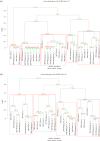Culturally transmitted song exchange between humpback whales (Megaptera novaeangliae) in the southeast Atlantic and southwest Indian Ocean basins
- PMID: 30564382
- PMCID: PMC6281946
- DOI: 10.1098/rsos.172305
Culturally transmitted song exchange between humpback whales (Megaptera novaeangliae) in the southeast Atlantic and southwest Indian Ocean basins
Abstract
In migratory marine species, investigating population connectivity and structure can be challenging given barriers to dispersal are less evident and multiple factors may influence individual movement patterns. Male humpback whales sing a song display that can provide insights into contemporary connectivity patterns, as there can be a cultural exchange of a single, population-wide shared song type with neighbouring populations in acoustic contact. Here, we investigated song exchange between populations located on the east and west coasts of Africa using 5 years of concurrent data (2001-2005). Songs were qualitatively and quantitatively transcribed by measuring acoustic features of all song units and then compared using both Dice's similarity index and the Levenshtein distance similarity index (LSI) to quantitatively calculate song similarity. Song similarity varied among individuals and potentially between populations depending on the year (Dice: 36-100%, LSI: 21-100%), suggesting varying levels of population connectivity and/or interchange among years. The high degree of song sharing indicated in this study further supports genetic studies that demonstrate interchange between these two populations and reinforces the emerging picture of broad-scale connectivity in Southern Hemisphere populations. Further research incorporating additional populations and years would be invaluable for better understanding of fine-scale, song interchange patterns between Southern Hemisphere male humpback whales.
Keywords: Africa; cultural transmission; humpback whale; population structure; song.
Conflict of interest statement
We declare we have no competing interests.
Figures



References
-
- Van Wyngaarden M, Snelgrove PV, DiBacco C, Hamilton LC, Rodríguez-Ezpeleta N, Jeffery NW, Stanley RR, Bradbury IR. 2017. Identifying patterns of dispersal, connectivity and selection in the sea scallop, Placopecten magellanicus, using RADseq-derived SNPs. Evol. Appl. 10, 102–117. (10.1111/eva.12432) - DOI - PMC - PubMed
-
- Palumbi SR. 1994. Genetic divergence, reproductive isolation, and marine speciation. Annu. Rev. Ecol. Evol. Syst. 25, 547–572. (10.1146/annurev.es.25.110194.002555) - DOI
Associated data
LinkOut - more resources
Full Text Sources

